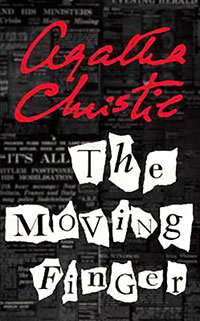
By Dennis Fischman
Anyone who has read a murder mystery has heard of Agatha Christie. Along with Dorothy Sayers, Margery Allingham, Josephine Tey, and some less-remembered authors like Gladys Mitchell, she is one of the British women who made up the Golden Age of Mystery in the early 20th century.
And anyone who has heard of Agatha Christie most likely has heard of Miss Jane Marple. From her home in the little village of St. Mary Mead, she studies human nature with a keen and jaundiced eye. Not for her the sleuthing of a Sherlock Holmes, nor the “little grey cells” of Christie’s other famous detective, Hercule Poirot. For her, it’s noticing how people act and react that reminds her of other people she has known, and that’s what lets her solve a mystery.

“The Moving Finger (Miss Marple #3)”
by Agatha Christie. Harper Collins, 2012.
In this book, we meet most of the characters before Miss Marple does. They appear at first to be types: the injured war hero, his flamboyant sister, the doctor, the lawyer, the unworldly vicar and his practical wife. The thing is, in this book, the types come to life with idiosyncratic traits and hidden depths. That’s why the mystery works. You wonder, “If I misjudged this person the first time or two I met them, perhaps they have more secrets? Perhaps they are really the murderer?”
The quiet little village of Lymstock seems the perfect place for Jerry Burton to recuperate from his flying accident under the care of his sister, Joanna, who would probably be more at home in London. They settle in for a round of daily walks and conversations with everyone else in the village, who are curious about the newcomers – they don’t see many, and not very often, either! But soon a series of vicious poison-pen letters destroys the village’s quiet charm, eventually causing one recipient to commit suicide. Then another person dies.
Are the deaths related? Do they happen because of the accusations (false or true) made in the letters? Who is writing them, and why? Which of these seemingly quirky people in this apparently bucolic town wants to kill other people’s reputations … or simply kill them?
One of the townspeople knows our Miss Marple and invites her to stay, but not until three-quarters of the book is done. By that time, we really have come to know and care about the villagers and their visitors, and the portrait of their lives is the best part of the book. The solution – with the characteristic Agatha Christie twist! – is both logical and satisfying, but it’s also in some ways beside the point. So, read this book if you enjoy British mysteries, but be prepared for it not to follow the usual pattern of detective novels.


















Reader Comments